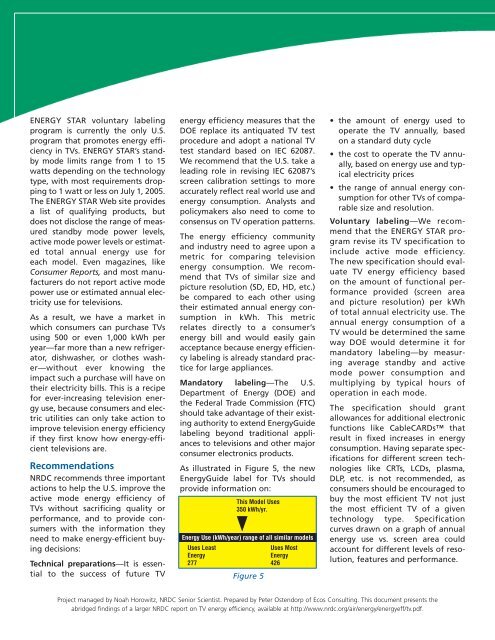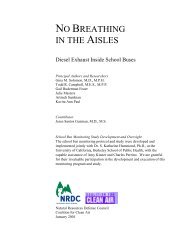NRDC: Prospects for Saving Energy in Televisions (pdf)
NRDC: Prospects for Saving Energy in Televisions (pdf)
NRDC: Prospects for Saving Energy in Televisions (pdf)
You also want an ePaper? Increase the reach of your titles
YUMPU automatically turns print PDFs into web optimized ePapers that Google loves.
ENERGY STAR voluntary label<strong>in</strong>g<br />
program is currently the only U.S.<br />
program that promotes energy efficiency<br />
<strong>in</strong> TVs. ENERGY STAR’s standby<br />
mode limits range from 1 to 15<br />
watts depend<strong>in</strong>g on the technology<br />
type, with most requirements dropp<strong>in</strong>g<br />
to 1 watt or less on July 1, 2005.<br />
The ENERGY STAR Web site provides<br />
a list of qualify<strong>in</strong>g products, but<br />
does not disclose the range of measured<br />
standby mode power levels,<br />
active mode power levels or estimated<br />
total annual energy use <strong>for</strong><br />
each model. Even magaz<strong>in</strong>es, like<br />
Consumer Reports, and most manufacturers<br />
do not report active mode<br />
power use or estimated annual electricity<br />
use <strong>for</strong> televisions.<br />
As a result, we have a market <strong>in</strong><br />
which consumers can purchase TVs<br />
us<strong>in</strong>g 500 or even 1,000 kWh per<br />
year—far more than a new refrigerator,<br />
dishwasher, or clothes washer—without<br />
ever know<strong>in</strong>g the<br />
impact such a purchase will have on<br />
their electricity bills. This is a recipe<br />
<strong>for</strong> ever-<strong>in</strong>creas<strong>in</strong>g television energy<br />
use, because consumers and electric<br />
utilities can only take action to<br />
improve television energy efficiency<br />
if they first know how energy-efficient<br />
televisions are.<br />
Recommendations<br />
<strong>NRDC</strong> recommends three important<br />
actions to help the U.S. improve the<br />
active mode energy efficiency of<br />
TVs without sacrific<strong>in</strong>g quality or<br />
per<strong>for</strong>mance, and to provide consumers<br />
with the <strong>in</strong><strong>for</strong>mation they<br />
need to make energy-efficient buy<strong>in</strong>g<br />
decisions:<br />
Technical preparations—It is essential<br />
to the success of future TV<br />
energy efficiency measures that the<br />
DOE replace its antiquated TV test<br />
procedure and adopt a national TV<br />
test standard based on IEC 62087.<br />
We recommend that the U.S. take a<br />
lead<strong>in</strong>g role <strong>in</strong> revis<strong>in</strong>g IEC 62087’s<br />
screen calibration sett<strong>in</strong>gs to more<br />
accurately reflect real world use and<br />
energy consumption. Analysts and<br />
policymakers also need to come to<br />
consensus on TV operation patterns.<br />
The energy efficiency community<br />
and <strong>in</strong>dustry need to agree upon a<br />
metric <strong>for</strong> compar<strong>in</strong>g television<br />
energy consumption. We recommend<br />
that TVs of similar size and<br />
picture resolution (SD, ED, HD, etc.)<br />
be compared to each other us<strong>in</strong>g<br />
their estimated annual energy consumption<br />
<strong>in</strong> kWh. This metric<br />
relates directly to a consumer’s<br />
energy bill and would easily ga<strong>in</strong><br />
acceptance because energy efficiency<br />
label<strong>in</strong>g is already standard practice<br />
<strong>for</strong> large appliances.<br />
Mandatory label<strong>in</strong>g—The U.S.<br />
Department of <strong>Energy</strong> (DOE) and<br />
the Federal Trade Commission (FTC)<br />
should take advantage of their exist<strong>in</strong>g<br />
authority to extend <strong>Energy</strong>Guide<br />
label<strong>in</strong>g beyond traditional appliances<br />
to televisions and other major<br />
consumer electronics products.<br />
As illustrated <strong>in</strong> Figure 5, the new<br />
<strong>Energy</strong>Guide label <strong>for</strong> TVs should<br />
provide <strong>in</strong><strong>for</strong>mation on:<br />
This Model Uses<br />
350 kWh/yr.<br />
<strong>Energy</strong> Use (kWh/year) range of all similar models<br />
Uses Least<br />
<strong>Energy</strong><br />
277<br />
Figure 5<br />
Uses Most<br />
<strong>Energy</strong><br />
426<br />
• the amount of energy used to<br />
operate the TV annually, based<br />
on a standard duty cycle<br />
• the cost to operate the TV annually,<br />
based on energy use and typical<br />
electricity prices<br />
• the range of annual energy consumption<br />
<strong>for</strong> other TVs of comparable<br />
size and resolution.<br />
Voluntary label<strong>in</strong>g—We recommend<br />
that the ENERGY STAR program<br />
revise its TV specification to<br />
<strong>in</strong>clude active mode efficiency.<br />
The new specification should evaluate<br />
TV energy efficiency based<br />
on the amount of functional per<strong>for</strong>mance<br />
provided (screen area<br />
and picture resolution) per kWh<br />
of total annual electricity use. The<br />
annual energy consumption of a<br />
TV would be determ<strong>in</strong>ed the same<br />
way DOE would determ<strong>in</strong>e it <strong>for</strong><br />
mandatory label<strong>in</strong>g—by measur<strong>in</strong>g<br />
average standby and active<br />
mode power consumption and<br />
multiply<strong>in</strong>g by typical hours of<br />
operation <strong>in</strong> each mode.<br />
The specification should grant<br />
allowances <strong>for</strong> additional electronic<br />
functions like CableCARDs that<br />
result <strong>in</strong> fixed <strong>in</strong>creases <strong>in</strong> energy<br />
consumption. Hav<strong>in</strong>g separate specifications<br />
<strong>for</strong> different screen technologies<br />
like CRTs, LCDs, plasma,<br />
DLP, etc. is not recommended, as<br />
consumers should be encouraged to<br />
buy the most efficient TV not just<br />
the most efficient TV of a given<br />
technology type. Specification<br />
curves drawn on a graph of annual<br />
energy use vs. screen area could<br />
account <strong>for</strong> different levels of resolution,<br />
features and per<strong>for</strong>mance.<br />
Project managed by Noah Horowitz, <strong>NRDC</strong> Senior Scientist. Prepared by Peter Ostendorp of Ecos Consult<strong>in</strong>g. This document presents the<br />
abridged f<strong>in</strong>d<strong>in</strong>gs of a larger <strong>NRDC</strong> report on TV energy efficiency, available at http://www.nrdc.org/air/energy/energyeff/tv.<strong>pdf</strong>.
















